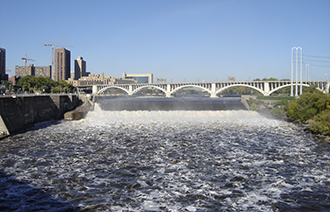The U.S. Army Corps of Engineers will reopen the Upper St. Anthony Falls Lock and Dam in Minneapolis briefly this spring to accommodate businesses hit hardest by the lock’s permanent closure expected in June.
The northernmost lock on the Mississippi River at MM 853.9 must close by June 10 under a provision in the Water Resources Reform and Development Act (WRRDA) of 2014. Supporters of the move said it was to protect the waterway from voracious Asian carp. Others said it was a way to get rid of river-dependent businesses and redevelop the area.
In its draft environmental assessment of the closing, the corps said it could reopen the lock in mid-March 2015 based on ice and flow conditions or not reopen it at all.
“We fully recognize that this decision will be applauded by some and criticized by others,” Col. Dan Koprowski, St. Paul District commander, said in a statement this week. “This is not a decision I made lightly. Certainly reopening the lock carries some limited risk, but that risk had to be balanced against the cost to the businesses that will be forced to transition away from inland waterway navigation as a result of the lock closure.”
Businesses will have to shift scrap metal and aggregate shipments from barge to either truck or rail at higher costs to be absorbed by them and their customers, the corps report noted. In one case, trucking the material will increase the cost of concrete in the local market by 5 to 9 percent, the corps said, citing a Metropolitan Council study.
Opening the lock to navigation this spring will save the industry an estimated $1.45 million to $2 million for shipping 291,000 tons of material. The cost to the corps to operate the lock until mid-June would be $130,000, the report said.
The June closure will mean the loss of 84 jobs and the addition of more than 21,000 truck trips a year to the highway system primarily during the work week, according to the report. The costs of shifting from barge to truck will increase $21.5 million through 2040, based on factors such as vehicle operating costs, added highway travel time, “and safety and environmental costs of moving the various types of commodities through the state by truck.”
Barge traffic through the lock averaged 755,834 tons annually from 2010 to 2014.
The impact on Asian carp is less clear. “The closest location where actual reproduction of Asian carp has been documented is about 400 river miles downstream of [the Upper St. Anthony lock],” the corps report said. Carp expansion on the Upper Miss “has been relatively slow over the last 20 years,” and the chance for appreciable numbers below the lock that might lock through above it “appears to be low.”
The corps’ final report is available here.




